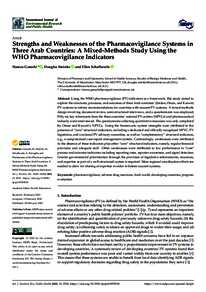وثيقة
Strengths and weaknesses of the pharmacovigilance systems in three Arab countries : a mixed-methods study using the WHO pharmacovigilance indicators.
المعرف
DOI: 10.3390/ijerph19052518
المصدر
International Journal of Environmental Research and Public Health. v. 19, 5, 2518
المساهمون
Steinke, Douglas., مؤلف
Schafheutle, Ellen., مؤلف
الدولة
Switzerland
الناشر
MDPI.
ميلادي
2022-03-01
اللغة
الأنجليزية
الملخص الإنجليزي
Using the WHO pharmacovigilance (PV) indicators as a framework, this study aimed to explore the structures, processes, and outcomes of three Arab countries’ (Jordan, Oman, and Ku-wait) PV systems to inform recommendations for countries with nascent PV systems. A mixed-methods design involving document review, semi-structured interviews, and a questionnaire was employed. Fifty-six key informants from the three countries’ national PV centres (NPVCs) and pharmaceutical industry were interviewed. The questionnaire collecting quantitative measures was only completed by Oman and Kuwait’s NPVCs. Using the framework, system strengths were attributed to the presence of “core” structural indicators, including a dedicated and officially recognised NPVC, PV legislation, and a national PV advisory committee, as well as “complementary” structural indicators, e.g., a computerised case-report management system. Contrastingly, weaknesses were attributed to the absence of these indicators plus other “core” structural indicators, namely, regular financial provision and adequate staff. Other weaknesses were attributed to low performance in “core” process and outcome indicators including reporting rates, reporter awareness, and signal detection. Greater governmental prioritisation through the provision of legislative enforce-ments, resources, and expertise as part of a well-structured system is required. More regional coor-dination efforts are needed to allow for sharing of expertise in order to bolster nascent systems.
ISSN
1661-7827
URL المصدر
قالب العنصر
مقالات الدوريات

